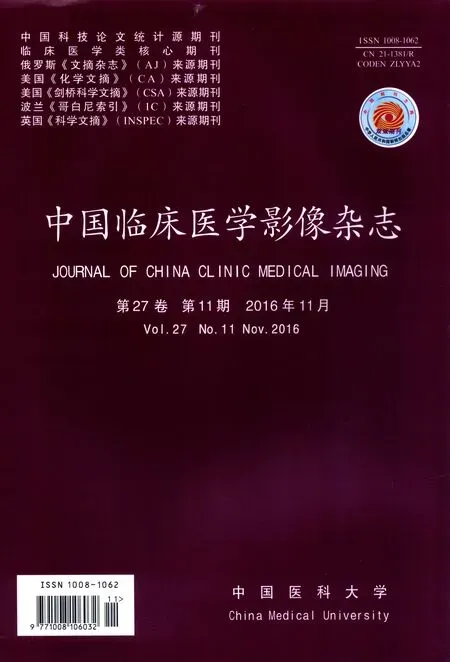PET/CT在颅脑损伤植物状态大脑功能的研究进展
2016-01-30李若金林承赫李贞兰
李若金,杜 昕,李 贺,林承赫,李贞兰
(吉林大学第一医院,吉林 长春 130021)
◁综述▷
PET/CT在颅脑损伤植物状态大脑功能的研究进展
李若金,杜 昕,李 贺,林承赫,李贞兰
(吉林大学第一医院,吉林 长春 130021)
严重颅脑损伤所致植物状态预后具有很大的差异,其意识不同水平决定着植物状态临床治疗和家庭护理的延续,因此准确判断意识障碍的类型和程度具有重要的临床指导意义。PET/CT通过放射性示踪剂定量反映大脑功能变化和残存活性,为意识障碍患者的诊断及预后评估提供客观依据。本文就PET/CT在颅脑损伤意识障碍诊断中的应用和大脑功能变化研究进展做一综述。
颅脑损伤;意识障碍;正电子发射断层显像术
重度颅脑损伤患者在恢复过程中经历不同程度的意识障碍,意识水平越低预后越差,所花费的医疗和护理费用也越大,给家庭造成巨大的精神心理压力和经济负担。因此早期准确判断意识障碍(Disorders of consciousness,DOS)水平和程度对康复治疗和家庭护理具有重要的指导意义。
目前常用修订版昏迷恢复量表 (Coma recovery scalerevised,CRS-R)[1-3]根据机体对外界刺激所产生的行为学改变评估意识状态[4]。然而,意识内容中心理活动、思想变化无法用行为学量表评估到,因此临床对意识水平的诊断准确率下降[4]。例如,微小意识状态(Minimally consciousness state,MCS)是意识的过渡状态[5],患者对环境可有微小的感知行为反应,却无法用言语或行为表达,被家属和医护人员所忽视,MCS被误认为植物状态 (Vegetative state,VS)的误诊率达30%~40%[6]。颅脑外伤后1年或非外伤性脑损伤后3月无任何意识恢复的迹象称为持续植物状态 (Persistent vegetative state,PVS)[7],颅脑外伤或脑卒中后PVS促醒率约为38%[8],而MCS较VS促醒效果明显[9-11],因此准确识别DOS水平对持续临床治疗以及个体化促醒治疗方案的制定具有重要指导意义。
CRS-R虽可帮助临床医师迅速判断DOS类型,但无法正确判断意识内容及大脑功能受损程度。近年来神经影像学研究发现,PET/CT通过提供大脑的功能与代谢信息,观察不同意识状态脑功能的变化[12]。Stender等[13]在18F-FDG PET/CT与CRS-R相关性研究中发现,二者诊断 MCS一致性为85%,灵敏度达93%;诊断VS一致性为67%。可见PET/CT可从分子水平提供不同条件下大脑功能代谢水平,为评估DOS不同意识水平和临床预后提供客观依据。本文就PET/CT在DOS应用进展做一综述,旨在为DOS的诊断、预后及个体化康复治疗方案提供客观依据。
1 PET/CT示踪剂反映大脑功能水平和程度
PET/CT通过放射性药物示踪剂反映大脑功能与代谢变化[12],18F-FDG提供大脑生理和病理状态下葡萄糖代谢变化,局部葡萄糖代谢率(Regional cerebral metabolic rate for glucose,RCMRG)反映大脑功能受损程度[14]。苯二氮卓受体是神经损伤高敏感性标识物,富含于大脑皮层,其密度反映神经系统的整合性。11C-氟马西尼(11C-flumazenil,11C-FMZ)为竞争性苯二氮卓受体 (Central-type benzodiazepine receptor,cBZR)拮抗剂,可间接反映神经元结构的完整性[15]。15O-H2O为脑部血流灌注显像剂,通过局部脑血流量(Cerebral blood flow,CBF)反映大脑血流灌注变化,从而反映大脑神经元激活区域[16]。
2 PET/CT研究植物状态大脑功能变化
2.1 大脑神经元损伤程度
Rudolf等[17]采用18F-FDG PET/CT及11C-FMZ PET/CT对VS 1月以内急性植物状态(Acute vegetative state,AVS)大脑葡萄糖代谢率 (Cerebral metabolic rate for glucose,CMRG)与苯二氮卓受体密度相关性进行了研究,发现AVS患者大脑幕上结构CMRG值和11C-FMZ结合位点数较正常人明显减少,大脑CMRG变化与FMZ结合位点数目变化正相关,而小脑FMZ结合位点数目无明显变化,表明AVS大脑代谢功能损伤伴有神经元结构受损。Heiss等[18]的研究结果证实了这一点。Shiga等[19]通过15O-O2PET/CT[20]和11C-FMZ PET/CT发现,fMRI未见异常的颅脑损伤 (Traumatic brain injury,TBI)患者大脑FMZ低结合区氧代谢率(Cerebral meabolic rate of oxygen,CMRO2)下降,部分区域CMRO2下降而FMZ结合正常。以上研究表明11C-FMZ PET/CT可直观显示大脑神经元结构受损程度,进而反映出大脑功能水平。
2.2 不同意识水平大脑代谢功能变化
1987年Levy等[21]首次通过18F-FDG PET/CT对VS、闭锁综合症(Locked-in syndrome,LIS)[22]CMRG进行了研究,发现VS大脑皮层灰质CMRG值低于正常值50%,基底核和小脑CMRG明显降低;LIS大脑皮层CMRG值较正常值下降25%。Rudolf等[17]用18F-FDG PET/CT研究发现VS大脑CMRG值明显降低,与Levy等[21]结果一致。Beuthien-Baumann等[23]对16例TBI后PVS患者使用18F-FDG PET/CT发现,PVS大脑皮层及皮层下灰质CMRG较正常值减少58%,而小脑蚓部仅减少16%,认为可能与机体的损伤程度有关。
Hattori等[24]应用18F-FDG PET/CT研究发现,23例格拉斯哥昏迷量表(GCS)8分TBI患者与正常人比较,TBI纹状体及丘脑CMRG显著下降,昏迷患者丘脑、脑干及小脑皮层CMRG值较未昏迷状态下降显著;CMRG与GCS相关性研究发现,丘脑、脑干及小脑CMRG值与GCS评分呈正相关,认为局部CMRG值反映机体神经元功能及不同意识水平。Johan等[25]对41例DOS大脑CMRG值进行比较,MCS 21例,VS 14例,意识模糊状态 (Emergence from the minimally consciousness state,EMCS)[26]7例,结果表明MCS大脑CMRG值为正常值55%,VS为正常值42%;VS及MCS大脑额顶叶CMRG值为正常值42%和60%,差异最显著,而脑干和丘脑区未见显著差异;EMCS和MCS未见显著差异。此研究结果提示大脑CMRG值可代表机体DOS不同水平,当大脑CMRG下降至正常值40%~50%时机体可能发生DOS。
研究认为维持意识需要大脑能量供应[14],Nakashima等[27]采用18F-FDG PET/CT对弥漫性颅脑损伤 (Traumatic diffuse brain injury,TDBI)大脑功能进行了研究,将51例患者分为A组(可进行语言交流,但存在认知功能障碍)、B组(MCS)和C组(VS),发现所有患者双侧额前叶皮层区、内侧额底皮层区、扣带回及丘脑能量代谢低下,其中VS患者大脑代谢低下最显著而且范围最广,认为大脑能量代谢程度反映DOS程度,保留的脑功能代谢区越多越有利于意识的恢复。
意识内容包括觉醒和觉知,觉知又分为内部及外部意识。内部意识指机体对外界刺激产生思想、想像、内心活动等,涉及楔前叶、扣带回及额中叶神经网络;外部意识指机体对外界环境的感知及反应能力等,涉及双侧额叶-颞叶-顶叶皮层神经网络[28]。Thibaut等[29]采用18F-FDG PET/CT发现VS内外意识神经网络及丘脑代谢障碍,其区域CMRG值显著下降;MCS内部意识网络及丘脑CMRG下降最为显著;EMCS扣带回及相邻胼胝体压部代谢障碍;LIS小脑代谢障碍。此研究结果提示神经网络功能的恢复有利于DOS的恢复,而内部意识神经网络的受损程度是影响意识恢复的重要因素,DOS程度与大脑能量代谢受损程度正相关。
3 外界刺激下大脑功能PET/CT研究
3.1 视觉刺激
Menon等[30]首次采用15O-H2O PET/CT观察了VS患者的大脑视觉信息处理通路,发现黑暗环境下闪光刺激使残存大脑功能区CBF增加;家人和无特定意义的照片偶可使患者产生视觉追踪,视觉梭形脸部区皮层网络激活,表明VS患者保留部分视觉处理网络功能。
3.2 声音刺激
Laureys等[31]应用15O-H2O PET/CT发现声音刺激下正常人和VS患者颞横回中部CBF较静息状态下高,此外正常人颞上回皮质区明显激活,而VS未见激活。心理-生理交互作用分析[32]研究发现VS大脑听觉皮层功能与缘上回、扣带回前部皮层及海马区等皮层间联系中断。Owen等[33]也发现PVS残存部分听觉功能。以上研究提示VS残存初级听觉皮层功能不能对声音进行整合处理,而皮层整合处理功能的恢复可能是VS意识好转所必需的先决条件。
Boly等[34]运用15O-H2O PET/CT对MCS和PVS声音处理网络通路进行了研究,发现声音刺激下PVS双侧颞横回中部(初级听皮层及听觉联合皮层)激活,激活范围较正常人显著缩小;MCS激活区域较PVS广泛,并累及到双侧颞上回及部分额前叶等高级听皮层区,提示MCS较PVS具有更广泛的皮层间功能联系,表明MCS较PVS具有更复杂的加工处理声音信息能力。
3.3 疼痛刺激
Kassubek等[35]对7例PVS患者进行正中神经电刺激,采用15O-H2O PET/CT观察发现刺激源同侧及对侧岛叶后部、中央后回及扣带回区CBF显著增加,提示PVS残余与疼痛相关的大脑皮层功能。Laureys等[36]发现疼痛刺激下正常人大脑初级躯体感觉皮层、双侧岛叶、缘上回及扣带回前部皮层等激活,而VS仅中脑、对侧丘脑及初级躯体感觉皮层激活。Boly等[37]研究结果与Laureys等[36]一致。以上研究表明VS虽残存大脑疼痛网络功能,却失去了与高级皮层间联系,故无法对疼痛信息进行整合加工处理而对外界刺激做出反应。
4 PET/CT在植物状态预后研究
Stender等[13]采用扩展版格拉斯哥结局量表(Glasgow outcome scale-extended,GOS-E)和18F-FDG PET/CT进行随访1年研究,发现PET/CT诊断为MCS的患者中67%意识恢复,24%死亡;VS患者中35%无意识好转,56%死亡;PET/CT结果与GOS-E随访结果明显相关,提示PET/CT更准确预示DOS预后。研究还发现CRS-R评分为VS而PET/CT显示大脑激活的13例患者1年后GOS-E评估,其中9例好转为MCS,3例死于并发症,1例仍为VS;而PET-CT未见大脑激活的VS患者意识均未得到恢复。Haibo等[38]亦发现仅初级皮层区激活的VS意识无明显的好转,而部分高级皮层区激活的VS患者82%意识恢复,提示PET/CT能够判断VS意识水平和预后。
5总结与展望
18F-FDG PET/CT定量反映大脑相关区域脑血流及葡萄糖代谢水平变化,进而定量反映DOS大脑功能损伤程度,为DOS意识水平的评估提供临床依据。但目前多数临床研究仅局限于观察DOS大脑功能受损区域变化,尚不明确机体意识水平恢复的大脑葡萄糖代谢阈值,大脑特定区葡萄糖代谢阈值变化对意识恢复的作用也未得以证实,需要未来大量的多中心研究。另一方面,11C-FMZ PET/CT可直观显示大脑神经元受损程度,而目前少有研究观察对比不同类型DOS患者神经元结构性损伤水平,其损伤程度对机体意识水平的影响尚待进一步研究,特定大脑功能区神经元结构的完整性对意识恢复的意义也需大样本的临床研究得以证实。15O-H2O可显示不同外界刺激下大脑局部血流量变化情况,进而反映机体外界信息神经处理通路的激活情况,研究发现VS多残存不同水平的信息处理通路功能,其对VS预后的影响缺乏长期的临床随访研究,未来可通过与GOS-E随访结果进行相关性研究,以对VS预后提供更多的临床指导意义。相信随着今后PET/CT临床研究的不断深入,将更准确的对意识障碍患者大脑功能水平及临床预后做出评估。
[1]Seel RT,Sherer M,Whyte J,et al.Assessment scales for disorders of consciousness:evidence-based recommendations for clinical practice and research[J].Arch Phys Med Rehabil,2010,91 (12):1795-1813.
[2]Caroline S,Steve M,Joseph G,et al.A French validation study of the Coma Recovery Scale-R(CRS-R)[J].Brain Inj,2008,22 (10):786-792.
[3]沈抒.修订版昏迷恢复量表简介及临床研究进展[J].中华物理医学与康复杂志,2015,37(8):628-630.
[4]Cruse D, Chennu S, Laureys S, et al. Bedside detection of awareness in the vegetative state: a cohort study[J]. Lancet, 2011,378(9809): 2088-2094.
[5]Giacino JT,Ashwal S,Childs N,et al.The minimally conscious state:definition and diagnostic criteria[J].Neurol,2002,58(2): 349-353.
[6]Schnakers C,Vanhaudenhuyse A,Giacino J,et al.Diagnostic accuracy of the vegetative and minimally conscious state:clinical consensus versus standardized neurobehavioral assement[J].Bmc Neurol,2009,9(1):1-5.
[7]Bender A,Jox RJ,Grill E,et al.Persistent vegetative state and minimally conscious state[J].Dtsch Arztebl Int,2015,112(14): 235-242.
[8]王永慧,张扬,马艳平,等.影响持续植物状态患者苏醒的多因素分析[J].中华物理医学与康复医学杂志,2010,32(3):212-215.
[9]Luauté J,Maucort-Boulch D,Tell L,et al.Long-term outcomes of chronic minimally conscious and vegetative states[J].Neurology, 2010,75(3):246-252.
[10]Giacino JT,Kalmar K.The vegetative and minimally conscious ststes:a comparison of clinical features and functional outcome [J].J Head Trauma Rehabil,1997,12(4):36-51.
[11]唐忠,温瑞.微意识状态与持续植物状态疗效的对比研究[J].中华神经医学杂志,2012,11(9):912-915.
[12]张红远,张祖进,郭召平,等.PET-CT的显像原理及临床应用[J].医疗卫生装备,2008,29(10):100-101.
[13]Stender J,Gosseries O,Bruno MA,et al.Diagnostic precision of PET imaging and functional MRI in disorders of consciousness: a clinical validation study[J].Lancet,2014,384(9942):514-522.
[14]Shulman RG,Hyder F,Rothman DL.Baseline brain energy supports the state of consciousness[J].Proc Nati Acad Sci,2009, 106(27):11096-11101.
[15]Geeraerts T,Coles JP,Aigbirhio FI,et al.Validation of reference tissue modeling for[11C]flumazenil positron emission tomography following head injury[J].Ann Nucl Med,2011,25(4): 396-405.
[16]Kudo K,Terae S,Katoh C,et al.Quantitative cerebral blood flow measurement with dynamic perfusion CT using the vascular-pixel elimination method:comparison with H215O positron emission tomography[J].Am J Neuroradiol,2003,24(3):419-420.
[17]Rudolf J,Sobesky J,Ghaemi M,et al.The correlation between cerebral glucose metabolism and bebzodiazepine receptor density in the acute vegetative state[J].Eur J Neurol,2002,9(3):671-677.
[18]Heiss WD,Grond M,Thiel A,et al.Permanent cortical damage detected by flumazenil positron emission tomography in acute stroke[J].Stroke,1998,29(2):454-461.
[19]Shiga T,Lkoma K,Katoh C,et al.Loss of neuronal integrity:a cause of hypometabolism in patients with traumatic brain injury without MRI abnormality in the chronic stage[J].Eur J Nucl Med Mol Imaging,2006,33(7):817-822.
[20]Baron JC,Jones T.Oxygen metabolism,oxygen extraction and positron emission tomography:historical perspective and impact on basic and clinical neuroscience[J].Neuroimage,2012,61(61): 492-504.
[21]Levy DE, Sidtis JJ, Rottenberg DA, et al. Differences in cerebral blood flow and glucose utilization in vegetative versus locked-in patients[J]. Ann Neurol, 1987, 22(6): 673-682.
[22]Bernat JL.Chronic disorders of consciousness[J].Lancet,2006, 367(4):1181-1192.
[23]Beuthien-Baumann B,Handrick W,Schmidt T,et al.Persistent vegetative state:evaluation of brain metabolism and brain perfusion with PET and SPECT[J].Nucl Med Commun,2003,24(24): 643-649.
[24]Hattori N,Huang SH,Yeh E,et al.Correlation of regional metabolic rates of glucose with glasgow coma scale after traumatic brain injury[J].J Nucl Med,2003,44(11):1709-1716.
[25]Johan S,Ron K,Anders R,et al.Quantitative rates of brain glucose metabolism distinguish minimally conscious from vegetative state patients[J].J Cere Blood F Met,2015,35(1):58-65.
[26]Perri CD,Thibaut A,Laurey S,et al.Measuring consciousness in coma and related states[J].World J Radiol,2014,6(8):589-597.
[27]Nakashima T, Iwama T, Naksyama A, et al. Relationship between regional cerebral metabolism and consciousness distur-bance in traumatic diffuse brain injury without large focal lesions:an FDG -PET study with statistical parametric mapping analysis [J]. J Neurol Neurosurg Psychiatry, 2006, 77 (7): 856-862.
[28]Demertzi A,Soddu A,Laureys S.Consciousness supporting networks[J].Curr Opin Neurobiol,2013,23(2):239-244.
[29]Thibaut A,Bruno MA,Chatelle C,et al.Metabolic activity external and internal awareness networks in severly brain damaged patients[J].J Rehabil Med,2012,44(6):487-494.
[30]Menon DK,Owen AM,Williams EJ,et al.Cortical processing in persistent vegetative state[J].Lancet,1998,352(9123):1148-1149.
[31]Laureys S,Faymonville MC,Fiore G,et al.Auditory processing in the vegetative state[J].Brain,2000,123(8):1589-1601.
[32]Friston KJ,Buechel C,Fink GR,et al.Psychophysiological and modulatory interactions in neuroimaging[J].Neuroimage,1997,6 (3):218-229.
[33]Owen AM,Coleman MR,Menon DK,et al.Residual auditory function in persistent vegetative state:a combined PET and fMRI study[J].Neuropsychol Rehabil,2005,15(3-4):290-306.
[34]Boly M,Faymonville MP,Lambermont B,et al.Auditory processing in severely brain injured patients:differences between the minimally conscious state and the persistent vegetative state [J].Arch Neurol,2004,61(2):233-238.
[35]Kassubek J, Juengling FD, Els T, et al. Activation of a residual cortical network during painful stimulation in long -term postanoxic vegetative state: a15O-H2O PET study[J]. Neurol Sci,2003, 212(1-2): 85-91.
[36]Laureys S, Damas P, Faymonvile ME, et al. Cortical processing of noxious somatosensory stimuli in the persistent vegetative state[J]. Neuroimage, 2002,17(2): 732-741.
[37]Boly M,Peigneux P,Lambermont B,et al.Cerebral processing of auditory and noxious stimuli in sverely brain injured patients: differences between VS and MCS[J].NeuropsycholRehabil, 2005,15(3-4):283-289.
[38]Haibo D,Boly MX,Ledoux D,et al.Neuroimaging activation studies in the vegetative state:predictors of recovery?[J].Clin Med,2008,8(5):502-507.
Research progress of PET/CT in brain function of vegetative state patients after traumatic brain injury
LI Ruo-jin,DU Xin,LI He,LIN Cheng-he,LI Zhen-lan
(The First Hospital of Jilin University,Changchun 130021,China)
Patients with severe traumatic brain injury often survive in vegetative state,and show a significant difference in the prognosis.The level of consciousness in these patients decides whether the clinical treatment and home care for them to be continued or not,thus it makes great sense in the diagnosis of the type and degree of disorders of consciousness.The degree of brain dysfunction can reflect the level of consciousness,PET/CT quantitatively shows the change of brain function and corresponding residual activity area by using radioactive tracer,and further provides the clinical objective evidence for the diagnosis and prognosis assessment.Then this article will make a summary on the research progress of PET/CT about residual brain’s function and diagnosis of disorders of consciousness in traumatic brain injury.
Craniocerebral trauma;Consciousness disorders;Positron-emission tomography
R651.15;R817.4
A
1008-1062(2016)11-0823-04
2016-03-15;
2016-03-30
李若金(1992-),女,河南驻马店人,在读硕士研究生。E-mail:jinnan1035528293@163.com
李贞兰,吉林大学第一医院康复科,130021。E-mail:zhenlanli66@163.com
